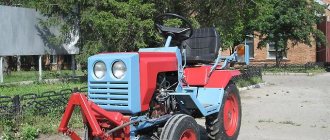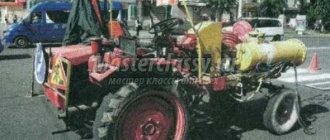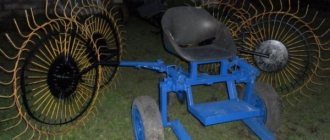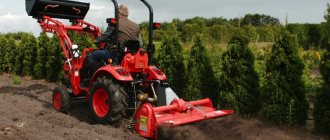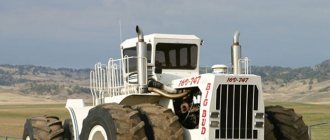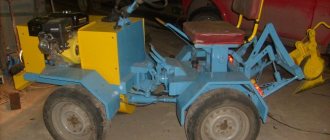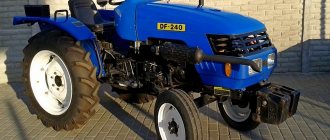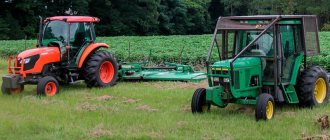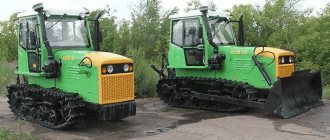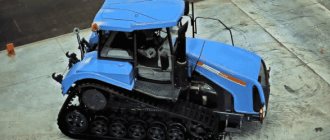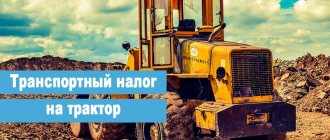Unlike world practice, where the size of a tractor is usually characterized by engine power, in Russia this is done by its nominal traction force, which depends on the type of suspension system and operating weight. The rated traction force is currently standardized by traction classes in accordance with GOST 27021-86. As practice has shown, it is this parameter that is considered the most stable and determines the possibility of aggregating a tractor with implements that have different working widths and, therefore, traction resistance, while such an indicator as power, used abroad, is less stable and largely depends on only on the type of propulsion device, but also on the speed of the machine-tractor unit (MTA) and soil conditions. The basis for constructing the type is the possibility of partial overlap of the ranges of traction forces of tractors in adjacent classes with an optimal minimum justified quantitative composition of models in each class. In other words, the type of domestic tractors is essentially a standard-size range of tractors produced (or being developed), grouped according to traction classes accepted in Russia (0.6; 0.9; 1.4; 2; 3; 4; 5; 6).
The towing classes and their corresponding rated towing force are shown in the table.
Table. Traction classes of tractors (classification of tractors by traction force)
| Traction class | Nominal traction force, kN |
| 0,2 | 1,8. ..5,4 |
| 0,6 | 5,4.8,1 |
| 0,9 | 8,1…12,6 |
| 1,4 | 12,6…18 |
| 2 | 18.. .27 |
| 3 | 27…36 |
| 4 | 36…45 |
| 5 | 45…54 |
| 6 | 54…72 |
A type, or tractor system, is a technically, technologically and economically sound set of all tractor models recommended for production. In each traction class, there are basic models (the main most popular tractors) and modifications, which are equipped with engines and a number of other components unified with the basic models. Their unification (uniformity) makes the manufacture and operation of tractors easier.
Model is a machine with a certain design and arrangement of units. The most common and universal model of tractors, which has specialized modifications, is called the basic one.
Modification is a modified base model. It is specialized in purpose and unified with the base model. A tractor brand is a conventional code name for a model of a certain design. To designate the brand of a tractor, first they write alphabetic characters indicating the abbreviated name of the manufacturer, the first letters of a certain word or a word characteristic of the tractor, and after a dash - a number indicating the engine power in horsepower or the model number.
It should be noted that today’s type is characterized by the absence in its most popular traction classes 1,4...3 of a number of tractors necessary for agriculture, while in the recent past, back in the USSR, the type of tractors was closer to the optimal due to the presence of the following important models tractors:
- wheeled tractors 4K4a of a classic layout from Belarus, traction classes 1,4.2 (PO MTZ, Minsk);
- wheeled tractors of the 4K4a, 4K4b and 4K4b' designs, as well as tracked tractors from Ukraine of traction classes 1.4 (PO "UMZ", Dnepropetrovsk) and 3 (PO "KhTZ", Kharkov).
Therefore, taking into account that PA "MTZ", PA "UMZ" and PA "KhTZ" are now outside Russia, we are forced today to independently create our own tractor manufacturing for the entire range of traction classes, primarily on the basis of tractors existing in the country, JSC "LTZ" ”, OJSC “VgTZ”, OJSC “Alttrak”, CJSC “PetTZ”, etc., closing the “white spots” in the domestic type of tractors.
In addition, the existing type of tractors does not provide for such high-power standard sizes necessary for agriculture, such as, for example, wheeled tractors 4K4a of a classic layout in traction classes 5.6 with a power of over 280 hp, wheeled tractors 4K4b' with an articulated frame in traction classes 6.7 with a power of over 400 hp, tracked tractors in traction classes 5.7 with a power of over 200,300 hp, and the range of 4K4a wheeled tractors with average power in the range of 180,280 hp, produced by AgroTechMash CJSC in small batches, is still very limited and cannot meet the market demand for this type of tractor.
A number of tractor factories (VMTZ, PetTZ, AgroTechMash) in recent years have increasingly begun to produce tractors in separate series of several standard sizes of the same type, differing little from each other in operating weight, i.e., belonging to the same traction class, but significantly in power engine (as is common in world practice), therefore in Russia they have increasingly begun to use a two-parameter classification of tractor types that is more convenient for consumers: by nominal traction force (the main parameter) and by engine power (an additional parameter).
The gradual improvement of the situation in the domestic tractor industry, mainly associated with the formation of powerful corporate structures covering the production of new standard sizes at most tractor factories, has led to the fact that factories have now begun to build their technical policy closer to the optimal or so-called promising type of tractors.
The real future need for a large range of wheeled and tracked tractors of various sizes and capacities, significantly exceeding the range of the existing type of tractors produced by domestic factories, is explained by the huge scale of Russia and its regions, the diversity of soil and climatic zones, a significant spread in the size of the areas of cultivated crops, and different specializations agricultural enterprises operating tractors, etc.
Since Belarusian and Ukrainian-made tractors are widespread in Russia, in further analysis we also included them in the analyzed size range.
Let's look at the main models and some modifications of agricultural tractors of various traction classes.
Tractors of traction class 0.2
Mini-tractors of traction class 0.2 (T-012, AMZhK-8, MTZ-082, MT-15, etc.) are designed for work in small-circuit, selection fields and on farms. They can be combined with a plow, mower, cultivator, trailed cart and other implements and machines made specifically for them.
A mini-tractor, or small-sized tractor, is a universal mobile power vehicle with a two-axle wheeled chassis or tracked propulsion.
The walk-behind tractor is a universal mobile power tool based on a single-axle chassis, controlled using rod levers by the operator following behind. Conventionally, the walk-behind tractor can be classified as traction class 0.1.
Power - tractor - Great Encyclopedia of Oil and Gas, article, page 1
Power - tractor
Page 1
The power of tractors is characterized by the maximum engine power at the governor and traction power under normal field conditions. [1]
Tractor power on the hook is 15 HP. With. Hourly fuel consumption (kerosene), 0 4 - 15 6 kg / hour. [2]
The tractor power balance shows how the power developed by the tractor engine is spent during operation. The equation showing the dependence of engine power on overcoming various types of resistance is called the power balance equation. [3]
The tractor power balance shows how the power developed by the tractor engine is spent during operation. [4]
The tractor's power take-off is used to drive a winch or other attachments. Sometimes ripper teeth are installed on the bulldozer blade (Fig. 42) for working on hard soils. [6]
Power take-off shaft of the Stalinets tractor - bO (fig. [7]
The tractor's power take-off shaft is connected by a cardan shaft to the unit's gearbox so that the axes of the shafts are aligned, and the reliability of the cardan shaft guard is checked. The tractor is braked, the fuel flow meter K. I-8910 is connected to the engine and air is removed from the power system. Turn on the unit and, by pressing the / / button (Fig. 11) Scroll, start the engine. Press button 12 Power and by changing the position of the liquid rheostat electrodes using buttons 15 and 16, gradually load the engine until the crankshaft rotation speed is close to the nominal one. C and relieve the load. Then check and, if necessary, adjust the crankshaft speed. [8]
An alternating current generator is connected to the tractor power take-off shaft and the crane operates from an electric drive. [10]
Powered by the tractor power take-off shaft. [eleven]
When the tractor power take-off shaft is turned on, bitumen from the thermos goes through the distribution valve, pump and hoses to the fishing rod and is applied to the surface being treated. [13]
Traction efficiency is the ratio of tractor hook power to engine power. [14]
It operates from the tractor's power take-off shaft. [15]
Pages: 1 2 3 4
www.ngpedia.ru
Tractors of traction class 0.6
Tractors and self-propelled chassis of traction class 0.6 (Belarus-320, T-30A, KhTZ-2511, VTZ-30SSh, SSh-25, T-16MG, etc.) are used for inter-row and pre-sowing cultivation, sowing, planting vegetable crops and gardens, crop care, hay harvesting, transport work and can operate stationary machines.
Self-propelled chassis is a type of tractor on the frame of which a loading platform for transporting goods is mounted or working parts of agricultural machines and implements, as well as units for work in public utilities, are mounted. Self-propelled chassis SSh-25 and T-16MG are used in vegetable growing, horticulture, field farming and livestock farming.
Reasons for loss of tractor power
A decrease in motor efficiency and loss of traction force of the equipment can be caused by a malfunction of the unit. To identify the actual loss of traction, brake tests are used using a special installation, which allows diagnostics to be performed without troubleshooting the motor.
Losses in engine efficiency are most often associated with a decrease in pressure in the cylinders due to wear of the piston group, coking of the piston rings or breakdown of the injectors. Also, a decrease in traction can occur due to the formation of carbon deposits on engine elements and the exhaust system. A sharp decrease in thrust during machine operation can be caused by a failure of the turbine or gas distribution mechanism.
Tractors of traction class 0.9
Tractors of traction class 0.9 (Belarus-422, LTZ-55, LTZ-55A, LTZ-55AN, VTZ-45AT, T-28X4M, etc.) due to a wide range of gears, reverse gear in all gears and adjustable wheel track used in many agricultural works (pre-sowing treatment, sowing, pest control, inter-row cultivation and harvesting of row crops, industrial and vegetable crops, plowing light soils in a small area and hay harvesting), as well as in transport work and for driving stationary machines.
Choosing a tractor: features and characteristics that need to be kept in mind
We have already written about how to choose the right mini-tractor, which will be useful on a small farm or on a summer cottage where the power of large-sized equipment is not required. Today we’ll talk about a full-size tractor and how to choose the right one.
Compared to a mini-tractor, a regular tractor has its disadvantages. It is not advisable to use it in small areas, for example, in vineyards: it may be difficult to move and also store this machine. In addition, a full-size tractor is much heavier than a miniature version and will not be as gentle on your lawn, so if the task is to preserve the landscape, then it makes sense to take a closer look at a mini tractor. Another drawback is the price of the tractor. While a Russian mini-tractor can be found for 500 thousand or less, the price of a tractor starts at a million rubles. You can buy a new or used tractor on our trading platform, where you can also buy attachments for the tractor. You can also rent a tractor.
However, there are tasks that a mini-tractor may not be able to cope with due to low engine power. These include the use of heavy attachments, as well as working with difficult soil (for example, frozen). In addition to these tasks, a full-size tractor is useful in construction, for cleaning areas, transporting goods and various earth-moving operations. This machine will become an indispensable assistant in agriculture and public utilities, when there is a need to process a large area.
What to look for when choosing a tractor?
Type of work performed
To clear snow, mow lawns, and plow a small garden, you won’t need the power of a large tractor; a medium-sized one can handle these jobs. For sowing, plowing large fields and harvesting, you will need a large tractor. The larger the area being processed, the more powerful the tractor will be required. However, when working in vineyards, for example, it is important to take into account the dimensions of the tractor so that it does not damage the plants when driving along the paths between them.
Attachments
If you need to transport heavy loads or crops, you need to purchase a trailer for the tractor. To clean the lawn or mow forage cereal crops, you will need a mower, for harvesting work - a rake, for transporting hay - a drag, an irrigator for watering a field or garden, and a plow for plowing. To remove snow, you can purchase a plow or a rotary snow blower; if you plan to use the tractor as a front-end loader, you will need to purchase additional buckets.
terms of Use
If you plan to use the tractor in central Russia, which is characterized by rain, slush and dirt, it is optimal to purchase a closed model with large wheels that will withstand bad weather. If the site where work is being done is hilly, bumpy or sticky, an all-wheel drive model is required, in which all wheels can be driven, and not just the rear ones, like a rear-wheel drive one. Such tractors are more powerful and will not get stuck if the road deteriorates due to bad weather.
Engine power
The engine power of the selected tractor determines how quickly it will move through difficult soil and how much fuel it will consume. In addition, engine power directly affects the comfort of using attachments, for example, how large a plow the tractor can pull. If you have to dig in poles, log stumps, do grader work, loosen and cultivate the soil, then you need a tractor with a power of at least 18.6 kW with the appropriate accessories. To deliver feed or work with large haystacks, you need a tractor with at least 37 kW. However, most full-size tractor engines have much more power.
Tractor dimensions
The size of the tractor determines not only whether it can work on the territory (will it pass between vineyards, will it not hit cars, and so on), but also the ability to use heavier attachments, as well as the load capacity of the machine. The larger the tractor, the heavier it is, which means the heavier awnings it can use and the heavier loads it can transport. If work with heavy canopies or loads is not required, and there is a need to carry out work in a limited space (for example, driving into a barn), you need a more miniature model or mini-tractor, or, as in the case of vineyards, a special model with a narrow wheelbase.
Which tractor should you choose?
Once you have determined that you need a full-size tractor: you need to work in large areas, in capricious weather conditions with difficult soil, and with heavy attachments, or you need to transport heavy loads. You also have a rough idea of what dimensions your tractor should have, attachments, engine power, and so on. Now you can move on to the direct choice of model, so we have compiled a small selection of tractors that you can pay attention to.
Petersburg Tractor Plant
PTZ has 12 agricultural tractors in its arsenal. Their carrying capacity varies from 4 (K-424 Premium) to 9 tons (K7-M), engine power from 240 (K-424 Premium and Premium-1) to 428 hp. All presented tractors are equipped with a closed cabin, which allows them to be used in bad weather. Kirovets K-424 is a universal farm tractor that is most effective for farms with arable land from 500 hectares to 2000 hectares. K7-M is useful for basic and pre-sowing tillage; they work effectively with seeders and seeding complexes for sowing both row and non-row crops and are suitable for transport work, fertilization, silage, snow retention, and road clearing. Both tractors are four-wheel drive. For K-424 you will have to pay about 5.7 million rubles, for K7-M - about 7.5 million.
The plant has a telegram bot, which you can ask questions about the operation of the equipment with photographs attached. You can purchase equipment on lease; preferential loans with low rates are available, which is important in times of crisis.
Minsk Tractor Plant
MTZ has 7 tractors in its arsenal, the engine power of which varies from 212 (BELARUS-2103) to 359 (Belarus-3522 and 3525) hp, they lift 8-10 tons, respectively. Models with tracked undercarriages (BELARUS-2103) are also presented, which are suitable for general-purpose work on waterlogged soil. Model 3525 is designed to perform energy-intensive agricultural work in traction and traction-drive modes as part of wide-cut and combined units, including echeloned mounting, on main and pre-sowing tillage, sowing grain and other crops, harvesting feed, harvesting root crops, grains and industrial crops; for carrying out transport work, stationary work, in construction and industry. Model 2103 can be found at a price of 9.9 million rubles, 3525 - about 10.7 million rubles.
Like PTZ, MTZ offers leasing programs for a period of 12 to 60 months.
John Deere
In Russia, the manufacturer presents 3 series of high-power tractors from 295 to 570 hp: 8R, 9R, 9RX in increasing power. The load capacity of the 8270R model is about 8.6 tons, 9570RX - 9 tons. The 9570RX is ideal for towing the heaviest loads and makes jobs like cultivating, plowing, loosening and planting much easier. The price for foreign tractors is corresponding: 9570RX
can be found for 33 million, 8270R - about 10 million rubles.
Case IH
The American company offers two lines of closed cab tractors with engine power exceeding 200 hp: Steiger and Magnum. There are 8 models in the Steiger line, some of them move on four tracked chassis, which have an increased contact area with the surface for increased cross-country ability. This allows you to get equipment into the field earlier than usual and overcome wet areas with an ease not available with conventional wheeled tractors or even tractors with two tracks. Tractor engines have power from 446 to 670 hp. and can move weights weighing up to 17.4 tons, lifting up to 5. The most powerful tractors in the line can be found for 25 million rubles.
Tractors of the Magnum line (there are 5 in total) lift up to 10.5 tons, their engine power varies from 285 to 375 hp. For tractors of this line you will have to pay up to 9 million rubles. The tractors have a built-in powerful lighting system, which will allow you to work around the clock in comfortable conditions.
Suokone
The Finnish company offers a tractor on a caterpillar chassis - MeriTractor MT-700. Various types of tracks can be installed on a tractor depending on the purpose and operating conditions. Steel tracks are suitable for hard surfaces where maximum mechanical strength is required. Rubberized tracks help when you need to move the tractor quickly: they provide travel speeds of up to 18 km/h (an additional option is hydraulic suspension). In conditions where the pressure on the ground should be minimal, it is possible to use dual rubberized tracks. Installation and removal of dual tracks is possible in the field. The tractor is offered in two versions with two different diesel engines: Volvo TAD 1643 VE (Tier 2) and Volvo TAD 1672 VE (Tier 4 Final). The latter is more environmentally friendly, but less powerful: 700 hp. versus 768. The carrying capacity of both is 9 tons. The price for mulchers from the same company reaches 5 million rubles.
Bottom line
You cannot do without a tractor if you need to cultivate a large area (for example, in agriculture or public utilities), which a mini-tractor cannot handle or will be ineffective. It is also useful if you need to work with difficult soil (for example, frozen) or heavy canopies, as well as transport and lift heavy loads. These tractors usually have an enclosed cab out of the box, which allows them to be used in winter or in bad weather without paying extra for it, as is the case with some mini tractors. When choosing a tractor, keep in mind the desired operating conditions of the tractor, size (vineyards will require a more compact model), required attachments (snow blower, trailer, plow, etc.), engine power (some equipment may require a more powerful engine).
Tractors of traction class 1.4
Tractors of traction class 1.4 (MTZ-80.1, MTZ-82, Belarus-923, YuMZ-6AKM, YuMZ-6DM, LTZ-60AB, etc.) are effectively used in cultivating and harvesting industrial and vegetable crops. In combination with mounted, semi-mounted and trailed agricultural machines and implements, they are used for plowing, cultivating, harrowing, sowing, planting, inter-row processing and forage preparation, spreading fertilizers, transportation, and also drive stationary machines.
To work in various conditions, tractors of 25 modifications of the Belarus brand are produced. They differ in configuration. For example, the Belarus-922 tractor has an 89 hp engine and all drive wheels. It has a synchromesh constant mesh gearbox with multiple gear ranges that shift on the fly, just like a car.
All basic models in traction classes 0.6; 0.9 and 1.4 are wheeled universal row-crop tractors. Their modifications include all-terrain tractors with all drive wheels, row crop tractors for tall crops with high agrotechnical clearance and mountain tractors for working on slopes.
Efficient tractor Class
Today, the German engineering company Claas enjoys mixed popularity. The in-demand technology has proven itself to be a reliable tool for high economic performance. New high-tech modifications of tractors can significantly reduce energy costs and at the same time qualitatively increase the efficiency of using German-made agricultural and industrial special equipment.
Detailed review of garden electric sprayers.
On this page you will watch a video of homemade trailers for walk-behind tractors.
Tractors of traction class 2
Tractors of traction class 2 (beet growing T-70SM and vineyard T-70V) are tracked. The T-90S tracked tractor, Belarus-1221, LTZ-155, LTZ-95 wheeled tractors and the Belarus SHU-356 universal chassis have been developed.
The Belarus-1221 tractor is equipped with a six-cylinder diesel engine with a power of 130 hp. with turbocharging. Shift-on-the-fly gearbox. The tractor is equipped with front and rear linkages and can be equipped with a power take-off shaft (PTO) gearbox and an additional PTO.
The LTZ-155 tractor is called integral because it combines (integrates) the components of various types of units - from simple to combined (combined). Engine power 150 hp A special feature of the integral tractor is its modular construction principle. It is assembled from three main parts-modules: energy, control and technological.
The energy module consists of a diesel engine, transmission, front drive axle with wheels, hitch and PTO.
The control module is a control station located in the cockpit. It can be rotated by 180° for continuous work in reverse, for example with drags or when harvesting as a combine.
The technological module is the rear axle in combination with various devices for working with agricultural implements and machines, a mounted harvesting unit for harvesting, a loading platform or fifth wheel for transport and even forestry work.
For tractors, it is possible to increase or decrease the agrotechnical clearance. Chassis SHU-356 with an 80 hp engine. designed to perform various agricultural field work and transport goods on a platform with a capacity of 2.5 m3.
Tractor traction efficiency
The traction efficiency determines the part of the power that is consumed by the motor to work with additional equipment and is an important parameter of its operation. Using traction efficiency, the transmission power consumption for towing one tractor is compared with another, which makes it possible to determine a more advanced model. The traction efficiency is determined by experiment or using special formulas.
The optimal traction efficiency on dense soils for wheeled vehicles is from 0.70 to 0.75, and for tracked vehicles from 0.75 to 0.80. When working with loose soils, the efficiency for a wheeled tractor should be 0.50–0.55, and for a tracked tractor - 0.65–0.75.
Most of the traction efficiency is spent on towing equipment, which is caused by insufficient adhesion of the drive wheels to the road or soil. Wheel towing should not be higher than 15–18%, and in the case of tracked vehicles, the parameter should not exceed 5%.
To increase the adhesion weight of the wheels, removable weights, lugs, and half-track attachments can be installed on them, which significantly increase the energy consumption of the unit for moving the tractor.
Tractors of traction class 3
Traction class 3 tractors (tracked DT-75D, DT-75N, DT-175M, VT-100, VT-130, DT-75ML, DT-75T, T-150, HTZ-180R, HTZ-200 and wheeled VT-130K , T-150K, T-15K, HTZ-12 are intended for basic tillage, sowing and harvesting, as well as for transport work. Wheeled tractors have all driven wheels of the same size.
The DT-175M tractor has a 170 hp engine. The transmission includes a torque converter to automatically change the speed of movement depending on the traction resistance of the gun.
The diesel engine of the VT-130 tractor is adjustable in power (145 hp and 120 hp). Power (145 hp) is provided by turbocharging with intermediate air cooling. The cabin tilts to one side and is equipped with an automated control system for tractor operation. The VT-130 and T-150 tracked tractors are unified in terms of the main assembly units with their wheeled modifications VT-130K and T-150K.
Technical and economic indicators of tractor operation | Tractors
The technical and economic indicators of tractors include, first of all, productivity and efficiency. MTA productivity is characterized by the volume of work (for example, cultivated field area) performed per unit of time, subject to agrotechnical requirements for the quality of this work. The profitability of tractors is characterized by the cost of work performed, which largely depends on the fuel efficiency of traction and power means. Thus, when assessing the productivity of tractors in combination with agricultural machines performing field work, the unit of measurement ha/h is used, and when assessing efficiency - kg/ha.
Main traction-speed and fuel-economic indicators of the tractor:
- traction force (or hook force) P (kN)
- travel speed V (km/h or m/s)
- traction (or hook) power Nкp (kW)
- hourly fuel consumption Gm (kg/h)
- specific gкp (g/(kWh)) fuel consumption
The traction power of a tractor, by analogy with the effective power of the engine, is determined at the junction of the tractor with the agricultural machine, i.e. on the hook. This power is spent on moving agricultural machines during work. Traction power, kW:
Ncr = Pcr*V / 3.6
In this formula, the unit of measurement Pcr is kN, V - km/h.
Specific fuel consumption, g/(kWh):
gcr = 10^3 * Gt / Ncr
The traction-speed and traction-economic characteristics of tractors depend on the traction load of the tractor, the gear engaged in the transmission and the soil background. The dependence of the actual speed V, slipping of the drive wheels 6, traction power Nкp., hourly GT and specific gкp fuel consumption on the traction force Ркр., obtained in different gears and soil backgrounds, is called the traction characteristic. To obtain the traction characteristics, traction tests of the tractor are carried out.
An example of traction characteristics in one of the gears (in general form without indicator values) is shown in the figure.
The tractor is characterized by three operating modes: idle, maximum traction power and maximum traction force.
Rice. Tractor traction characteristics in one gear
At idle, Pkr = 0, and the values of Nkp, V, b, Gt and gkp are determined by the starting points of these curves lying on the O-N axis.
In the mode of maximum traction power Nкp max, the values of all quantities are determined by points A', B, C and E lying at the intersection of the curves with the vertical line ON which passes through point B' of the top of the traction power curve. The force corresponding to Nкp max is called nominal. It is used to evaluate the possibility of aggregating a tractor with a particular machine, comparing its traction resistance with the nominal value of Pcr.
In the mode of maximum traction force Pcr max, the values of all quantities are determined by points A, B, C, B and E, lying at the intersection of the curves with the vertical 0″N, which is drawn through the point Pcrmax. This section characterizes the ability of the tractor to operate with short-term overload without changing to a lower gear.
Specific fuel consumption with increasing Pcr (starting from Pcr = 0) decreases, taking a minimum value approximately at the point Ncr max, and with overload, as a rule, it increases. This means that the most economical mode corresponds to the tractor operating at maximum traction power.
Traction characteristics are used to solve problems of rational aggregation of tractors with agricultural machines, establishing standards for the production and fuel consumption of tractor units.
When carrying out technical and economic calculations, not physical, but conditional (reference) tractors are often used. For this purpose, coefficients for converting physical tractors into conditional ones are used.
But these coefficients are outdated. Since July 2, 2009, the “Methodology for using conditional coefficients for converting tractors, grain harvesters and forage harvesters into standard units when determining the standards of their needs” has been in effect, approved by the Ministry of Agriculture of the Russian Federation.
ustroistvo-avtomobilya.ru
Tractors of traction class 5
Tractors of traction class 5 are used to perform soil cultivation, transport and other agricultural work.
The basic model is the K-701 wheeled tractor, the unified model is the K-701M. Equipped with a 12-cylinder diesel engine with a power of 305 hp. Forward speed 3.66...30 km/h, reverse 6.4...23 km/h, track width 2100 mm, ground clearance 500 mm, weight 13,590 kg.
The T-5 “Donchak” tracked tractor, equipped with an SMD-37 engine with a power of 250 hp, belongs to the same class.
4.2.3 Calculation of tractor power balance
We calculate the required engine power Ne and its cost components from the power balance equation:
Ne = Ntr + Nf + Nb ± Ni ± Nj + Ncr, kW,
Ne – required (calculated) effective engine power, kW
Ntr = [Ne]·(1-ηtr), kW - power of mechanical losses in the transmission, kW
[Ne] - nameplate effective engine power, kW [MU adj. 7 p.1]
[Ne] = 58.8 kW
ηtr - transmission efficiency (for tracked tractors ηtr = 0.86-0.88) (see Appendix
Ntr = 58.8 · (1-0.88) = 7.06 kW
Nf = Рf·V·, kW - power consumed for self-propulsion of the tractor, kW
V—unit speed, m/s
Nf = 14.4 0.7 = 10 kW
Nb = ([Ne] - Ntr) δ, kW - power expended on slipping the drive wheels or tracks of the tractor
δ—slip coefficient (when working with traction load), δ=0.02-0.06—for tracked tractors;
Nb = (58.8 – 7.06) 0.06 = 3.1 kW
Ni = ± Рi·V, kW - power consumed to overcome the rise
Ni = 18.8 0.7 = 13.2 kW
Nj = ± Рj·V, kW - power required to overcome the inertia forces of the unit,
Nj = 10.9 · 0.7 =7.6 kW
Ncr = Pcr·V, kW - power consumed for traction of the aggregated machine,
Ncr = 2.6 0.69 = 1.8 kW
Since the previous calculations were carried out in kN, the calculations immediately result in kW. The forces Рf, Рi, Рj, Ркр are taken from the calculation of traction balance.
Ne = 7.06+10+3.1+13.2+7.6+1.8= 42.8 kW
Compare the calculated required power Ne with the motor nameplate power [Ne]: Ne ≤ [Ne] must be obtained.
[Ne] = 58.8 kW
42,8 ≤ 58,8
Conclusion: the tractor’s power is sufficient to operate the implement, therefore no technical changes are required.
We also determine the traction efficiency of the tractor by the degree of use of the effective required engine power:
thrust= 1.8/42.8= 0.04
According to the degree of use, the traction efficiency of a tractor is not considered normal, because the following is considered normal: [thrust] = 0.7-0.75.
Conclusion: From the calculation of the tractor power balance, it is clear that the normal load of the tractor is not obtained; the degree of engine load of the LHT-55 tractor is too low. It is necessary to increase the load on the tractor.
Solutions:
Traction efficiency depends on:
- power loss in the transmission when slipping,
- self-propulsion,
- when climbing a slope,
- degree of loading.
Loss of tractor power is caused by loss of traction force or loss of speed. Losses in the transmission and slipping account for speed losses, while those for moving the tractor and for overcoming an incline constitute power losses.
Therefore, it is best to change this tractor to a less powerful one.
4.2.4. Calculation of unit performance indicators
a) Calculation of unit performance
The productivity of a unit is the amount of work (km, ha, m3 and in other units) performed by it per unit of time (hour, shift, season). The most convenient for comparing units and easily converted into other units is productivity, measured in linear units, in km/h, km/cm.
When characterizing equipment, the following types of productivity in linear units are used:
— Wо = Vav- per hour of main time, km/h,
- Wcm = Wо·Ксм = Vср·Ксм - per hour of shift time, km/h,
— Wek = Wo·Kek = Vav·Kek — per hour of operating time,
where Vav is the average speed of the unit during the shift, km/h;
Vav = 2.2 km/h (see Appendix 7 MU)
Ksm = To/Tsm - shift time utilization factor, where To is the time of main, useful work, h; Tcm = 8 hours – shift duration.
Ksm – 0.5
Kek is the coefficient of utilization of operating time; it additionally takes into account all downtime of the unit associated with the elimination of its technical failures (in the Kyrgyz Republic, high technical reliability of equipment is conventionally accepted, i.e. Kcm = Kek).
For a new unit: Wcm = 2.2 · 0.5 = 1.1 km/h
Wek = 2.2 · 0.5 = 1.1 km/h
Wcm = 0.1 · Vpr · Vav · Kcm = 0.1 · 5.6 · 2.2 · 0.5 = 0.6 ha/h (per hour of shift time)
Wcm = 0.1 · Vpr · Vav · Ksm · T = 0.1 · 5.6 · 2.2 · 0.5 · 8 = 5 ha/cm (per shift)
For the base unit: Wcm= 0.06 km/h
Wcm= 0.06 8 = 0.5 ha/cm
studfiles.net
General layout of tractors
The operational properties of a tractor depend on the main parameters that ensure: cross-country ability (on terrain, in row-spacings between plants, in row-spacings under and above plants), maneuverability, permissible impact of propulsion on the soil, aggregation, required speed ranges, traction properties, convenience maintenance and repair.
The layout of the tractor is the relative placement of the main units and equipment, allowing it to perform functions with the highest efficiency, and is characterized by the base, track, ground clearance, dimensions of the propellers, axle load, location of the engine, cabin and controls, coordinates of the center of mass, taking into account machines and working equipment . When assembling the tractor, it is necessary to ensure:
- structural linkage of dimensions along the width of the propellers and along their outer edges with technological equipment, taking into account the purpose of the tractor. For general-purpose tractors, the width along the outer edges of the propulsors should exclude asymmetrical application of the load, causing the occurrence of a moment that turns the tractor and moving it away from the given direction of movement, which reduces the need for frequent action on the controls. When using tractors with trailers that have their own propellers, the track must ensure that they can move along one track;
- high traction performance with good controllability and stability through rational distribution of the load on the chassis supports, including taking into account its redistribution from the action of traction resistance and the weight of technological equipment;
- ease of control and landing of the tractor driver, good visibility of the path, working machines and equipment;
- maneuvering on the headland and high directional stability;
- minimal labor costs when connecting the tractor with machines and implements and the ability to assemble and control them by one tractor driver;
- convenient maintenance during operation, disassembly and assembly during repair;
- high technology in manufacturing, operation and repair.
***
About soil and its cultivation
Home page
- Applicant's page
Distance education
- Group TO-81
- Group M-81
- Group TO-71
Specialties
- Veterinary
- Agricultural mechanization
- Commerce
- Vehicle maintenance and repair
Academic disciplines
- Engineering graphics
- MDK.01.01. "Car design"
- Section map
- General structure of the car
- car engine
- Car transmission
- Steering
- Brake system
- Suspension
- Wheels
- Body
- Car electrical equipment
- Basic car theory
- Basics of technical diagnostics
- Fundamentals of hydraulics and heat engineering
- Metrology and standardization
- Agreecultural machines. Agreecultural equipment
- Basics of agronomy
- Transportation of dangerous goods
- Materials Science
- Management
- Technical mechanics
- Tips for graduate student
